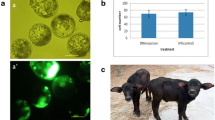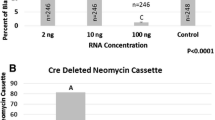Abstract
Lentiviral technology has been recently proposed to generate transgenic farm animals more efficiently and easier than traditional techniques. The objective was to evaluate several parameters of lambs obtained by lentiviral transgenesis in comparison with non-transgenic counterparts. In vitro produced embryos were microinjected (TG group) at two-cell stage with a lentiviral construct containing enhanced green fluorescent protein (eGFP) gene, while embryos produced by in vitro fertilization (IVF group) or intrauterine insemination (IUI group) were not microinjected. Microinjection technique efficiently generated eight-cell transgenic embryos (97.4 %; 114/117). Development rate on day 5 after fertilization was similar for TG (39.3 %, 46/117) and IVF embryos (39.6 %, 44/111). Pregnancy rate was detected in 50.0 % (6/12) of recipient ewes with TG embryos, in 46.7 % (7/15) with IVF embryos, and in 65.0 % (13/20) of IUI ewes (P = NS). Nine lambs were born in TG group, six lambs in IVF group, and 16 lambs in IUI group. All TG lambs (9/9) were GFP positive to real-time PCR and eight (88.9 %) showed a strong and evident GFP expression in mucosae, eyes and keratin tissues. Fetal growth monitored every 15 day by ultrasonography did not show significant differences. Transgenic lambs neither differ in morphometric variables in comparison with non transgenic IVF lambs within 3 months after birth. Transmission of the transgene to the progeny was observed in green fluorescent embryos produced by IVF using semen from the TG founder lambs. In conclusion, this study demonstrates the high efficiency of lentiviral technology to produce transgenic sheep, with no clinic differences in comparison with non transgenic lambs.






Similar content being viewed by others
References
Andreeva LE, Serova IA (1992) The effect of the micromanipulations used for transgenesis on mouse development. Ontogenez 23(6):637–643
Behboodi E, Anderson GB, BonDurant RH, Cargill SL, Kreuscher BR, Medrano JF, Murray JD (1995) Birth of large calves that developed from in vitro-derived bovine embryos. Theriogenology 44(2):227–232
Chavatte-Palmer P, Remy D, Cordonnier N, Richard C, Issenman H, Laigre P, Heyman Y, Mialot JP (2004) Health status of cloned cattle at different ages. Cloning Stem Cells 6(2):94–100
Cognie Y, Poulin N, Locatelli Y, Mermillod P (2004) State-of-the-art production, conservation and transfer of in vitro-produced embryos in small ruminants. Reprod Fertil Dev 16(4):437–445
Cohen J (1991) Assisted hatching of human embryos. J In Vitro Fert Embryo Transf 8(4):179–190
Cornetta K, Tessanne K, Long C, Yao J, Satterfield C, Westhusin M (2013) Transgenic sheep generated by lentiviral vectors: safety and integration analysis of surrogates and their offspring. Transgenic Res 22(4):737–745
Deng S, Li G, Zhang J, Zhang X, Cui M, Guo Y, Liu G, Li G, Feng J, Lian Z (2013) Transgenic cloned sheep overexpressing ovine toll-like receptor 4. Theriogenology 80(1):50–57
Dropulic B (2011) Lentiviral vectors: their molecular design, safety, and use in laboratory and preclinical research. Hum Gene Ther 22(6):649–657
Farin PW, Farin CE (1995) Transfer of bovine embryos produced in vivo or in vitro: survival and fetal development. Biol Reprod 52(3):676–682
Farin PW, Crosier AE, Farin CE (2001) Influence of in vitro systems on embryo survival and fetal development in cattle. Theriogenology 55(1):151–170
Farin PW, Piedrahita JA, Farin CE (2006) Errors in development of fetuses and placentas from in vitro-produced bovine embryos. Theriogenology 65(1):178–191
Follenzi A, Ailles LE, Bakovic S, Geuna M, Naldini L (2000) Gene transfer by lentiviral vectors is limited by nuclear translocation and rescued by HIV-1 pol sequences. Nat Genet 25(2):217–222
Hammer RE, Pursel VG, Rexroad CE Jr, Wall RJ, Bolt DJ, Ebert KM, Palmiter RD, Brinster RL (1985) Production of transgenic rabbits, sheep and pigs by microinjection. Nature 315(6021):680–683
He X, Li H, Zhou Z, Zhao Z, Li W (2012) Production of brown/yellow patches in the SLC7A11 transgenic sheep via testicular injection of transgene. J Genet Genomics 39(6):281–285
Hejnar JA, Hájková P, Plachí JA, Elleder D, Stepanets V, Svoboda J (2001) CpG island protects Rous sarcoma virus-derived vectors integrated into nonpermissive cells from DNA methylation and transcriptional suppression. PNAS 98(2):565–569
Hofmann A, Kessler B, Ewerling S, Weppert M, Vogg B, Ludwig H, Stojkovic M, Boelhauve M, Brem G, Wolf E, Pfeifer A (2003) Efficient transgenesis in farm animals by lentiviral vectors. EMBO Rep 4(11):1054–1060
Holm P, Walker SK, Seamark RF (1996) Embryo viability, duration of gestation and birth weight in sheep after transfer of in vitro matured and in vitro fertilized zygotes cultured in vitro or in vivo. J Reprod Fertil 107(2):175–181
Jaenisch R (1976) Germ line integration and Mendelian transmission of the exogenous Moloney leukemia virus. Proc Natl Acad Sci USA 73(4):1260–1264
Kong Q, Wu M, Huan Y, Zhang L, Liu H, Bou G, Luo Y, Mu Y, Liu Z (2009) Transgene expression is associated with copy number and cytomegalovirus promoter methylation in transgenic pigs. PLoS One 4(8):e6679
Krisher R, Gibbons J, Canseco R, Johnson J, Russell C, Notter DR, Velander W, Gwazdauskas FC (1994) Influence of time of gene microinjection on development and DNA detection frequency in bovine embryos. Trans Res 3(4):226–231
Kues WA, Niemann H (2011) Advances in farm animal transgenesis. Prev Vet Med 102(2):146–156
Kvell K, Czompoly T, Hiripi L, Balogh P, Kobor J, Bodrogi L, Pongracz JE, Ritchie WA, Bosze Z (2010) Characterisation of eGFP-transgenic BALB/c mouse strain established by lentiviral transgenesis. Transgenic Res 19(1):105–112
Lillico S, Vasey D, King T, Whitelaw B (2011) Lentiviral transgenesis in livestock. Transgenic Res 20(3):441–442
Liu C, Wang L, Li W, Zhang X, Tian Y, Zhang N, He S, Chen T, Huang J, Liu M (2013) Highly efficient generation of transgenic sheep by lentivirus accompanying the alteration of methylation status. PLoS One 8(1):e54614
Lois C (2011) Generation of Transgenic Animals with Lentiviral Vectors. In: Pease S, Saunders TL (eds) Advanced Protocols for Animal Transgenesis. Springer Protocols Handbooks, Springer, Berlin, pp 181–211
Lois C, Hong EJ, Pease S, Brown EJ, Baltimore D (2002) Germline transmission and tissue-specific expression of transgenes delivered by lentiviral vectors. Science 295(5556):868–872
Lonergan P, Fair T (2008) In vitro-produced bovine embryos: dealing with the warts. Theriogenology 69(1):17–22
McEvoy TG, Robinson JJ, Sinclair KD (2001) Developmental consequences of embryo and cell manipulation in mice and farm animals. Reproduction 122(4):507–518
Menchaca A, Rubianes E (2004) New treatments associated with timed artificial insemination in small ruminants. Reprod Fertil Dev 16(4):403–413
Miao K, Guo M, An L, Xu XL, Wu H, Wang D, Wu ZH, Tian JH (2011) A new method to efficiently produce transgenic embryos and mice from low-titer lentiviral vectors. Transgenic Res 20(2):357–363
Nakagawa T, Hoogenraad CC (2011) Lentiviral transgenesis. In: Hofker MH, van Deursen J (eds) Transgenic Mouse Methods and Protocols, vol 693. Humana Press, NY, pp 117–142
Park F (2007) Lentiviral vectors: are they the future of animal transgenesis? Physiol Genomics 31(2):159–173
Parrish JJ, Susko-Parrish JL, Leibfried-Rutledge ML, Critser ES, Eyestone WH, First NL (1986) Bovine in vitro fertilization with frozen-thawed semen. Theriogenology 25(4):591–600
Pfeifer A (2004) Lentiviral transgenesis. Transgenic Res 13(6):513–522
Popova EA, Krivokharchenko AS, Vil’yanovich LI (2002) In vitro development of murine embryos using different types of microinjections. Russ J Dev Biol 33(2):81–84
Prasher DC, Eckenrode VK, Ward WW, Prendergast FG, Cormier MJ (1992) Primary structure of the Aequorea victoria green-fluorescent protein. Gene 111(2):229–233
Reichenbach M, Lim T, Reichenbach HD, Guengoer T, Habermann FA, Matthiesen M, Hofmann A, Weber F, Zerbe H, Grupp T, Sinowatz F, Pfeifer A, Wolf E (2010) Germ-line transmission of lentiviral PGK-EGFP integrants in transgenic cattle: new perspectives for experimental embryology. Transgenic Res 19(4):549–556
Remy S, Nguyen TH, Menoret S, Tesson L, Usal C, Anegon I (2010a) The use of lentiviral vectors to obtain transgenic rats. In: Anegon I (ed) Rat Genomics, vol 597. Humana Press, NY, pp 109–125
Remy S, Tesson L, Usal C, Menoret S, Bonnamain V, Nerriere-Daguin V, Rossignol J, Boyer C, Nguyen TH, Naveilhan P, Lescaudron L, Anegon I (2010b) New lines of GFP transgenic rats relevant for regenerative medicine and gene therapy. Transgenic Res 19(5):745–763
Ritchie WA, King T, Neil C, Carlisle AJ, Lillico S, McLachlan G, Whitelaw CB (2009) Transgenic sheep designed for transplantation studies. Mol Reprod Dev 76(1):61–64
Singer O, Verma IM (2008) Applications of lentiviral vectors for shRNA delivery and transgenesis. Curr Gene Ther 8(6):483–488
Tian Y, Li W, Wang L, Liu C, Lin J, Zhang X, Zhang N, He S, Huang J, Jia B, Liu M (2013) Expression of 2A peptide mediated tri-fluorescent protein genes were regulated by epigenetics in transgenic sheep. Biochem Biophys Res Commun 434(3):681–687
Vajta G, Gjerris M (2006) Science and technology of farm animal cloning: state of the art. Anim Reprod Sci 92(3–4):211–230
van Wagtendonk-de Leeuw AM, Aerts BJG, den Daas JHG (1998) Abnormal offspring following in vitro production of bovine preimplantation embryos: a field study. Theriogenology 49(5):883–894
van Wagtendonk-de Leeuw AM, Mullaart E, de Roos APW, Merton JS, den Daas JHG, Kemp B, de Ruigh L (2000) Effects of different reproduction techniques: AI, moet or IVP, on health and welfare of bovine offspring. Theriogenology 53(2):575–597
Walker SK, Hartwich KM, Seamark RF (1996) The production of unusually large offspring following embryo manipulation: concepts and challenges. Theriogenology 45(1):111–120
Whitelaw CB, Lillico SG, King T (2008) Production of transgenic farm animals by viral vector-mediated gene transfer. Reprod Domest Anim 43(2):355–358
Wilson JM, Williams JD, Bondioli KR, Looney CR, Westhusin ME, McCalla DF (1995) Comparison of birth weight and growth characteristics of bovine calves produced by nuclear transfer (cloning), embryo transfer and natural mating. Anim Reprod Sci 38(1–2):73–83
Young LE, Sinclair KD, Wilmut I (1998) Large offspring syndrome in cattle and sheep. Rev Reprod 3(3):155–163
Acknowledgments
The authors wish to thank Alison Creneguy for the technical labor in the production of recombinant lentivirus, Robert Wijma for technical help during in vitro embryo production, Sofía Ramírez for technical assistance during fetal measurement, and Sabrina Olmos, Fatima Rodríguez and Santiago Machado for nursing and handling of newborns. This project was financially supported by ANII PR_FSA_2009_1_1333 grant, FOCEM (MERCOSUR Structural Convergence Fund), COF 03/11 and received additional support by PEDECIBA (UdelaR) and Union Agriculture Group. MC, MV, IA and AM are fellows of Sistema Nacional de Investigadores (SNI).
Ethical standards
All procedures that include animal handling were approved by the Animal Care Committee of the Fundación IRAUy and certified by the National Council of Animal Care of Uruguay and have therefore been performed in accordance with the ethical standards laid down in the 1964 Declaration of Helsinki and its later amendments. All persons gave their informed consent prior to their inclusion in the study.
Author information
Authors and Affiliations
Corresponding author
Rights and permissions
About this article
Cite this article
Crispo, M., Vilariño, M., dos Santos-Neto, P.C. et al. Embryo development, fetal growth and postnatal phenotype of eGFP lambs generated by lentiviral transgenesis. Transgenic Res 24, 31–41 (2015). https://doi.org/10.1007/s11248-014-9816-x
Received:
Accepted:
Published:
Issue Date:
DOI: https://doi.org/10.1007/s11248-014-9816-x




